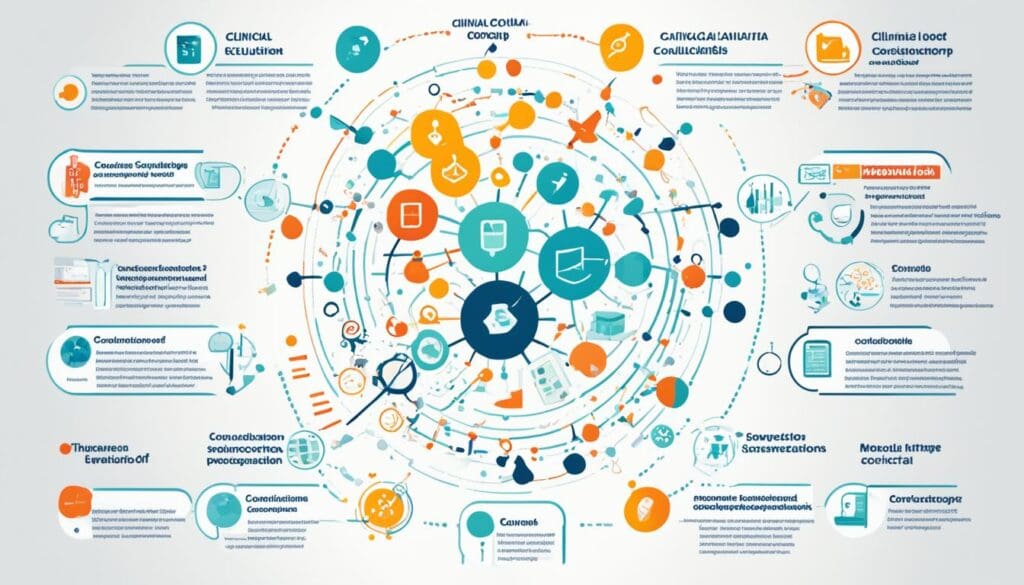Vaccines save 2–3 million lives every year. It’s crucial to understand how they work. These studies help prevent serious illness and cut down on hospital stays. They also help improve health strategies.
The primary endpoint is key in clinical trials. It measures how well vaccines work. But, vaccine efficacy and effectiveness are different. Efficacy shows how well vaccines work under perfect conditions. Effectiveness shows how well they work in real life.

The World Health Organization says vaccines have greatly reduced child deaths. This shows how important vaccine trials are. These trials use different groups to test vaccines.
Controlled trials are often used to test vaccines. They can be randomized or cluster randomized. Observational studies like cohort and case-control also help us see how vaccines work in real life.
Looking into vaccine efficacy studies shows us their importance. They are thorough and have a big impact on public health. For more on research identifiers and their role, check out Understanding ORCID and Its Benefits.
Key Takeaways
- Vaccine efficacy measures the percentage reduction of disease cases in vaccinated versus unvaccinated groups.
- Controlled trials and observational study designs play a crucial role in evaluating vaccine efficacy.
- Comparator arms in studies can vary from placebo to delayed vaccination strategies.
- The primary endpoint is a critical measure in clinical trials assessing vaccine efficacy.
- WHO estimates that 2–3 million lives are saved annually due to immunization programs.
Introduction to Vaccine Efficacy Studies
Vaccine Efficacy Studies are key in fighting severe diseases and saving lives. They test how well vaccines work against different viruses, like SARS-CoV-2 variants. These studies also look at how long the vaccine’s protection lasts.
This section explains why these studies are important, their history, and their effect on health.
Importance of Vaccine Efficacy
Vaccine efficacy is crucial. It shows how well a vaccine works in real situations. For instance, the Haemophilus influenzae type b (Hib) vaccine greatly lowers the risk of serious meningitis in Uganda and Senegal.
In South Africa, the 7-valent pneumococcal conjugate vaccine helped protect both HIV-infected and healthy children from serious infections. These examples show how Vaccine Efficacy Studies keep people safe.
Historical Context
The history of Vaccine Efficacy Studies is filled with important moments. From Edward Jenner’s smallpox vaccine to the big advances in the 1950s, vaccines have made a huge difference.
The introduction of the rotavirus vaccine in places like Israel and El Salvador has cut down on serious diarrhea in kids. These events prove vaccines are powerful tools against infectious diseases.
Impact on Public Health
The effect of vaccines on health is huge. They have led to fewer deaths and lower child mortality rates. In Colombia, the Hib vaccine stopped many cases of bacterial pneumonia. In Pakistan, it reduced pneumonia in young kids.
Recent studies on COVID-19 vaccines, like Pfizer & BioNTech and Moderna, show we must keep watching and improving vaccines. They fight against new variants like Delta and Omicron.
In summary, Vaccine Efficacy Studies are vital. They help us see how vaccines reduce illness and death. This makes them key to keeping and improving global health.
Vaccine Trial Design
Creating a solid vaccine trial design is key to making sure vaccines work well and are safe. We must think about many things like the vaccine type, what we’re measuring, who’s in the study, and what they’re compared to. This design is crucial for showing how well the vaccine prevents disease and its effects on different groups of people.
In studies like the Pfizer and BioNTech trial in early 2022, we see how important vaccine trial design is. They looked at an Omicron-based COVID-19 vaccine. Also, the ChAdOx1 nCoV-19 vaccine was tested in Brazil, South Africa, and the UK. The results came out in Lancet in 2021.
| Study | Year | Key Findings |
|---|---|---|
| ChAdOx1 nCoV-19 Vaccine Trials | 2021 | Efficacy against SARS-CoV-2 in multiple regions (Brazil, South Africa, UK) |
| Pfizer/BioNTech Omicron Vaccine Study | 2022 | Investigation of Omicron-specific COVID-19 vaccination in adults |
| Ebola Guinea Ring Vaccination Trial | 2017 | Final results show rVSV-vectored vaccine efficacy |
Vaccine trials have main goals and extra ones, like looking at behavior or how different groups react. For example, some trials wait to give the vaccine to the placebo group to see long-term effects. This is often seen in COVID-19 studies, as reported by Annals of Internal Medicine.
How long we follow up in these trials is crucial to understand the vaccine’s lasting effects. Ebola vaccine trials used complex models to predict success chances during an epidemic. This shows the need for smart and flexible vaccine trial designs.
Following rules from top health groups like WHO, FDA, and EMA makes sure trials are right and fair. These rules have changed a lot, especially with new pandemics, to make COVID-19 vaccination trials better.
Immunogenicity Assessment
Understanding how well a vaccine works and its safety is key. We measure the immune response to a vaccine to see if it protects against diseases. The strength of the immune response depends on the vaccine type, the health of the people getting it, and how it’s given.
Understanding Immunogenicity
Immunogenicity means how well a vaccine makes the body respond. Healthy young adults and pregnant women often make strong antibodies against flu vaccines. But, this can be weaker in young kids, older people, and those with health issues.
Adults and older kids usually only need one flu vaccine shot a year to be protected. Young kids might need two doses, given four weeks apart, to get enough immunity. Back in 1976, kids got half the vaccine dose to avoid side effects. Now, they get the full dose to boost their immune system.
Laboratory Methods for Assessment
Scientists use different tests to check how well vaccines work. Adjuvants help vaccines work better with less antigen. Vaccines given under the skin can also work as well as shots in the muscle or under the skin.
The hemagglutination inhibition (HI) test is a common way to check for flu antibodies. It helps make sure the results are the same everywhere. Other tests also help us understand how well vaccines work against bird flu in people.
In conclusion, testing how well vaccines work is crucial. It makes sure vaccines are safe and effective. This helps prevent and control diseases.
Clinical Endpoint Evaluation
In the world of Vaccine Efficacy Studies, clinical endpoint evaluation is key. It shows how vaccines work in real life. By looking at severe outcomes like hospitalization, we see how well vaccines prevent serious illness. This process looks at both the main goals and any unexpected results, covering many important areas.

- Primary Endpoints: Includes parameters like incidence of disease, reduction in disease severity, and hospitalization rates.
- Estimation Models: Employ advanced statistical models to estimate vaccine effectiveness.
- Secondary Endpoints: Covers aspects such as prevention of infection transmission and other longer-term impacts.
- Safety Endpoints: Monitors adverse effects and overall safety of the vaccine.
Many studies show why clinical endpoint evaluation is vital in vaccine research:
| Study | Focus | Findings |
|---|---|---|
| International Randomised Trial | COVID-19 Candidate Vaccines | Highlighted the crucial role of clinical endpoints in understanding vaccine effectiveness. |
| Draft Landscape | COVID-19 Candidate Vaccines | Outlined the clinical endpoints necessary for evaluating candidate vaccines. |
| Performance Characteristics | Abbott Architect SARS-CoV-2 IgG Assay | Provided insights into the immunological responses used as clinical endpoints. |
| Efficacy and Safety | Dengue Vaccine | Demonstrated long-term safety endpoints in regions of endemic disease. |
Statistical Analysis Methods
Using the right statistical methods is key to understanding how well vaccines work. These methods help fix data biases, especially when looking at vaccine effectiveness studies.
Common Statistical Techniques
Randomized and observational study designs are the main tools for vaccine trials. Randomized studies, often double-blind, cut down on biases and give clear results. Observational studies let scientists see how vaccines work in real life.
The CDC uses many statistical methods for accuracy. For example, the PoDBAY (Probability of Disease Bayesian Analysis) framework uses immune response data to figure out vaccine efficacy. This method can give accurate results early on, mainly using data on how the vaccine affects the immune system.
Also, finding immune correlates of protection (CoPs) speeds up vaccine development. Continuous CoP models show how immune responses and protection are linked. This helps make vaccines faster.
Interpreting Results
Understanding vaccine trial results takes a deep look at how well vaccines work. The efficacy (VE) shows how much less disease risk there is among those who got the vaccine compared to those who didn’t. Different methods like threshold models and continuous CoP models give different views on the data.
Threshold models think that protection starts once a certain immune response level is reached. Continuous models show how immune responses and protection levels keep changing. These views are key when thinking about how trial results affect health policies.
Simulation methods check how accurate vaccine efficacy estimates are. By using statistical analysis, researchers can get important insights. This helps in quickly approving vaccines that work well.
| Study | Location | Vaccine Type | Effectiveness |
|---|---|---|---|
| de Andrade ALSS et al., 2004 | Brazil | Hib Conjugate | 33% |
| Adegbola R et al., 2005 | The Gambia | Hib Conjugate | Successful Elimination |
| Daza P et al., 2006 | Malawi | Hib Conjugate | Considerable Effectiveness |
| Baqui A et al., 2007 | Bangladesh | Hib Conjugate | High Effectiveness |
| Muganga N et al., 2007 | Rwanda | Hib Conjugate | Notable Impact |
| Lee E et al., 2008 | Uganda | Hib Conjugate | Significant Role |
Adverse Event Monitoring
In the world of vaccine studies, adverse event monitoring is key. It helps us understand and talk about vaccine safety. This is very important during health crises when people might doubt the vaccines.
For example, when the Pfizer-BioNTech COVID-19 vaccine came out in December 2020 in the U.S., they watched for allergic reactions like anaphylaxis closely. Before that, in 1999, the rotavirus vaccine was stopped because of intussusception cases. Since then, they’ve kept a close eye on it, especially for babies.

They look back at past data too, like the risk of narcolepsy after a vaccine in 2009. They also checked if the inactivated flu vaccine caused Bell’s palsy in Switzerland. This shows how important it is to keep watching.
Big vaccination drives show us how key it is to know the usual disease rates. Studies together helped look into Guillain-Barré Syndrome after the 2009 flu vaccines. Keeping an eye on bad reactions is crucial for vaccine safety and keeping trust.
Looking into intussusception after rotavirus shots in Africa shows the worldwide effort for vaccine safety. The National Vaccine Injury Compensation Program helps balance rights and community good. It shows the careful steps needed to protect public health.
Regulatory Guidelines in Vaccine Studies
Ensuring vaccines are safe and work well is crucial. Regulatory guidelines help a lot in this effort. The CDC, FDA, and WHO work with global partners to make rules for vaccine development. These rules aim to prevent bad outcomes and boost public health. They give clear advice to vaccine makers and researchers.
Overview of Regulatory Bodies
Important groups like the FDA, EMA, and WHO set the rules for vaccine studies worldwide. Their guidelines cover safety checks, making vaccines, and submitting trial data for approval.
- FDA (Food and Drug Administration): Gives full guidance on making, testing, and approving vaccines in the U.S.
- EMA (European Medicines Agency): Works with the FDA to set strict rules, helping approve vaccines in the European Union.
- WHO (World Health Organization): Shares advice, combining global health views.
Compliance and Approval Processes
Following the rules makes sure vaccines are safe and effective. The FDA says vaccines need to show at least a 50% success rate to get approved. Developers must talk to regulatory bodies early to make sure their studies meet the needed standards.
| Study Type | Purpose | Regulatory Focus |
|---|---|---|
| Non-clinical Studies | Evaluate safety in animal models | Potential safety issues, immunogenicity |
| Clinical Trials | Assess safety and efficacy in humans | Safety, efficacy, immune response |
| Post-Licensure Studies | Monitor long-term effects | Adverse events, long-term efficacy |
Guidelines stress the need for clear communication about vaccine science. This keeps the public trusting in vaccines. For more on regulatory rules, check out the detailed advice here.
Herd Immunity Considerations
Herd immunity is key to protecting communities from outbreaks. It means a certain percentage of people need to be immune, either through vaccines or past illnesses. This helps stop diseases like measles and smallpox from spreading.
The measles vaccine is a good example. To stop the disease from spreading, most people need to be vaccinated. This is also true for COVID-19, where getting vaccinated is crucial. The World Health Organization (WHO) explains the risks of not vaccinating enough people.
Vaccines help everyone, not just those who get them. They lower the chance of the disease spreading. This protects even those who haven’t had the vaccine.
It’s important to look at how vaccines affect the whole population. We use things like vaccine effectiveness and the basic reproduction number (R0) to figure this out. This helps make health policies that protect everyone.
Scoping reviews help us understand the big picture of vaccination. They ask questions and combine data to find what we need to know. You can learn more about these reviews in guides like the scoping review usage guide.
FAQ
What are the Principles of Vaccine Efficacy Studies?
Vaccine efficacy studies aim to measure how well vaccines prevent serious illness or death. They look at reducing hospital visits and lowering the need for medical care. These studies use different designs and methods to get accurate results. They consider how people react, their immune responses, and possible biases.
Why are Vaccine Efficacy Studies important?
These studies are key to knowing how vaccines work against diseases. They guide health policies and vaccination efforts. They show the vaccine’s protection against infection, severe cases, and death, especially in emergencies.
What is the historical context of Vaccine Efficacy Studies?
Vaccine efficacy studies began in the early 1900s. They’ve seen major advances, like Edward Jenner’s smallpox vaccine. By the 1960s, national vaccination programs started. These efforts have greatly reduced child deaths and controlled infectious diseases worldwide.
How do vaccine efficacy studies impact public health?
They’re crucial for making sure vaccines are safe and work well. This helps stop diseases from spreading, lowers healthcare costs, and saves lives. The data guides vaccination efforts and responses to outbreaks.
What factors are considered in vaccine trial design?
Designing vaccine trials involves looking at what effects to measure and the study groups. It also looks at the comparison groups and how long the study goes on. The methods used to analyze the data are key to understanding long-term effects and early signs of immunity.
What is immunogenicity assessment in vaccine studies?
Immunogenicity assessment checks how vaccines trigger an immune response. It uses lab tests to measure immune markers like antibodies. This helps understand vaccine effectiveness and is crucial for vaccine development and rules.
How are clinical endpoints evaluated in vaccine studies?
Evaluating clinical endpoints checks if vaccines prevent serious health issues like hospital stays and deaths. The main outcome of interest is the primary endpoint. Secondary endpoints might look at preventing spread and reducing symptoms.
What are the common statistical analysis methods used in vaccine efficacy studies?
Researchers use randomized trials, observational studies, and models for analysis. These methods help deal with biases, make sense of the data, and give strong evidence on vaccine safety and effectiveness.
How is adverse event monitoring conducted in vaccine studies?
Monitoring adverse events means tracking and studying any bad effects seen during and after vaccine tests. This is key for making sure vaccines are safe, getting approval, and keeping trust in vaccines.
What is the role of regulatory guidelines in vaccine studies?
Guidelines make sure vaccine studies meet safety, effectiveness, and quality standards. Agencies like the FDA and WHO set rules for trial design, data analysis, and approval. This protects public health.
How do herd immunity considerations impact vaccine study designs?
Thinking about herd immunity looks at how widespread vaccination can stop disease spread in communities. Vaccine studies check how vaccines protect at a community level. This helps shape vaccination policies and health strategies.
Source Links
- https://www.who.int/docs/default-source/blue-print/working-group-for-vaccine-evaluation-(4th-consultation)/ap1-guidelines-online-consultation.pdf – PDF
- https://www.nature.com/articles/s41577-020-00479-7 – A guide to vaccinology: from basic principles to new developments – Nature Reviews Immunology
- https://en.wikipedia.org/wiki/Vaccine_efficacy – Vaccine efficacy
- https://www.ncbi.nlm.nih.gov/pmc/articles/PMC7007298/ – Case-control vaccine effectiveness studies: Preparation, design, and enrollment of cases and controls
- https://www.healthdata.org/research-analysis/diseases-injuries/covid/covid-19-vaccine-efficacy-summary – COVID-19 vaccine efficacy summary | Institute for Health Metrics and Evaluation
- https://www.ncbi.nlm.nih.gov/pmc/articles/PMC6613811/ – Considerations for the design of vaccine efficacy trials during public health emergencies
- https://www.ncbi.nlm.nih.gov/pmc/articles/PMC8882397/ – WHO guidance on COVID-19 vaccine trial designs in the context of authorized COVID-19 vaccines and expanding global access: Ethical considerations
- https://www.sciencedirect.com/topics/biochemistry-genetics-and-molecular-biology/vaccine-immunogenicity – Vaccine Immunogenicity – an overview
- https://www.ncbi.nlm.nih.gov/pmc/articles/PMC10975834/ – Evaluation of Vaccine Immunogenicity—Correlates to Real-World Protection: Influenza
- https://www.ncbi.nlm.nih.gov/pmc/articles/PMC7596738/ – Clinical Endpoints for Evaluating Efficacy in COVID-19 Vaccine Trials
- https://www.ncbi.nlm.nih.gov/pmc/articles/PMC8969448/ – SARS-CoV-2 vaccines: Clinical endpoints and psychological perspectives: A literature review
- https://www.nature.com/articles/s41541-021-00377-6 – A method to estimate probability of disease and vaccine efficacy from clinical trial immunogenicity data – npj Vaccines
- https://www.ncbi.nlm.nih.gov/pmc/articles/PMC7008029/ – Case-control vaccine effectiveness studies: Data collection, analysis and reporting results
- https://www.ncbi.nlm.nih.gov/pmc/articles/PMC7846216/ – General determination of causation between Covid-19 vaccines and possible adverse events
- https://www.ncbi.nlm.nih.gov/pmc/articles/PMC7111503/ – Causality assessment of adverse events following immunization: the problem of multifactorial pathology
- https://www.ema.europa.eu/en/human-regulatory-overview/public-health-threats/coronavirus-disease-covid-19/covid-19-public-health-emergency-international-concern-2020-23/covid-19-vaccines-studies-approval – COVID-19 vaccines: studies for approval
- https://www.niaid.nih.gov/clinical-trials/vaccine-clinical-studies-safeguards – Vaccine Clinical Studies Safeguards
- https://jme.bmj.com/content/49/9/636 – Herd immunity, vaccination and moral obligation
- https://academic.oup.com/cid/article/52/7/911/299077 – “Herd Immunity”: A Rough Guide
- https://www.ncbi.nlm.nih.gov/books/NBK538382/ – Vaccination and Herd Immunity: Individual, Collective, and Institutional Responsibilities – The Ethics of Vaccination